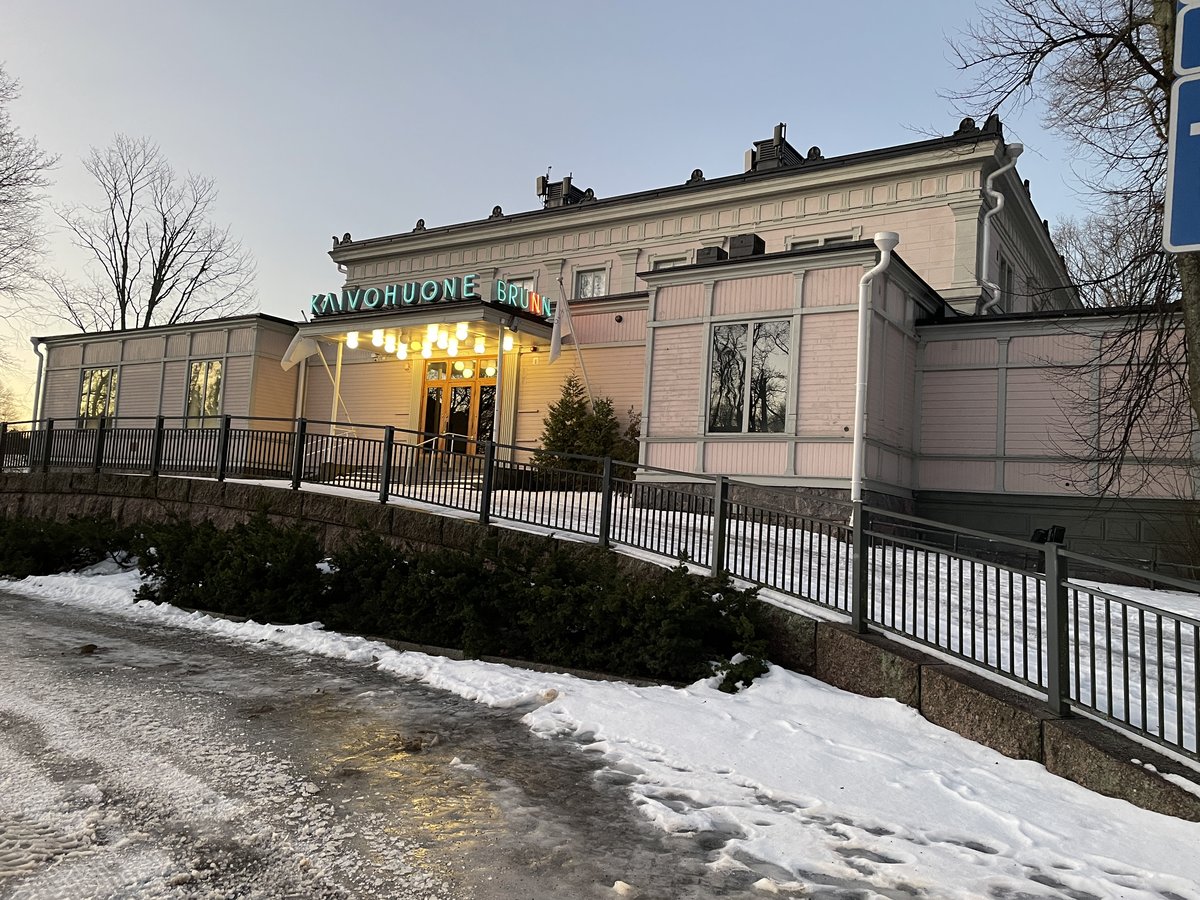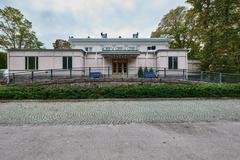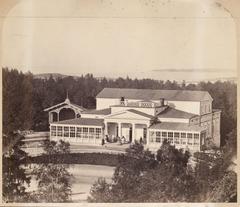
Kaivohuone Helsinki: Visiting Hours, Tickets, and Historical Site Guide
Date: 14/06/2025
Introduction
Kaivohuone stands as one of Helsinki’s most treasured historical landmarks, nestled within the lush expanse of Kaivopuisto Park. Erected in 1838 and conceived by famed architect Carl Ludvig Engel, the building has served as a spa, restaurant, entertainment venue, and, most recently, a celebrated nightclub. Kaivohuone’s neoclassical architecture, layered with Neo-Renaissance additions, embodies Helsinki’s transformation from a provincial town into a cosmopolitan capital. Though the venue permanently closed its doors in late 2024, its legacy endures as a monument to cultural evolution and architectural heritage—visible to all who stroll through the vibrant park that surrounds it.
This guide offers a detailed look at Kaivohuone’s history, architectural features, visiting information, accessibility, and nearby attractions, ensuring that travelers and history enthusiasts can fully appreciate this Helsinki icon—even if only from the outside. For the latest details, consult official resources (Kaivohuone Wikipedia; YLE; Lonely Planet).
Table of Contents
- Historical Overview
- Architectural Features
- Kaivohuone’s Role in Helsinki Society
- Recent Developments and Current Status
- Visitor Information: Hours, Tickets, and Accessibility
- Exploring Kaivopuisto Park and Nearby Landmarks
- Seasonal Events and Festivals
- Photography, Safety, and Practical Tips
- Frequently Asked Questions (FAQ)
- Future Prospects for Kaivohuone
- References
Historical Overview
Established in the early 19th century, Kaivohuone was born out of a vision to transform Helsinki’s southern shores into a fashionable spa and recreational district (vihreatsylit.fi). Entrepreneur Henrik Borgström leased the land in 1834 and, together with Engel’s architectural expertise, created a luxurious destination for the city’s elite and Russian nobility. The venue quickly became a focal point for social events, offering healthy cuisine, mineral water invented by Victor Hartwall, and a stage for concerts, dances, and theatrical performances (thephotorecord.org).
Throughout the 19th century, Kaivohuone evolved alongside Helsinki’s growing reputation as a cultural hub. The adjacent Park Theatre, commissioned by restaurateur Louis Kleineh in 1858 and expanded in 1863, introduced vaudeville, opera, and ballet to local audiences before its closure in the 1870s (vihreatsylit.fi).
Architectural Features
Kaivohuone is a prime example of neoclassical architecture, with later Neo-Renaissance enhancements. Engel’s original villa-style design, characterized by symmetry and grand facades, was complemented by Theodor Höijer’s ornate renovations in 1867 (vihreatsylit.fi). The building encompasses approximately 2,524 m², spread across two main floors and a basement, and features high-ceilinged interiors, crystal chandeliers, and refined period detailing (Kaivohuone official PDF).
A notable addition on the grounds is the 1952 Olympic restroom—a rare surviving example of Finnish 1950s functionalist design (Kaivohuone official PDF).
Set within Kaivopuisto Park, Kaivohuone’s large outdoor terrace and its harmonious integration with the surrounding landscape have been central to its enduring appeal (VybeFul).
Kaivohuone’s Role in Helsinki Society
Initially a retreat for aristocrats and Russian nobles, Kaivohuone’s strict codes of decorum reflected the exclusivity of 19th-century leisure culture. Over time, the venue became more accessible, mirroring the democratization of public recreation in Finland (vihreatsylit.fi). The grounds were meticulously landscaped to provide sweeping views of the sea, and the building became synonymous with summer dances, concerts, and open-air gatherings that defined Helsinki’s social calendar.
Kaivohuone’s significance expanded in the 20th century, symbolized by the planting of the Tree of Independence in 1917—a living testament to Finland’s national identity (vihreatsylit.fi). Throughout its history, the venue adapted to changing tastes, serving as a restaurant, cabaret, police school, and, ultimately, a celebrated nightclub known for summer terrace parties and celebrity events (Nightflow; RaveLife).
Recent Developments and Current Status
In October 2024, after 186 years of continuous operation, Kaivohuone closed its doors to the public (YLE). The City of Helsinki now owns the property and is evaluating future uses for the historic building. As of June 2025, there are no public events, guided tours, or restaurant services available inside Kaivohuone. Visitors may continue to admire its façade and explore the vibrant Kaivopuisto Park, but interior access is not permitted.
Visitor Information: Hours, Tickets, and Accessibility
Visiting Hours
Kaivohuone is currently closed to the public. There are no official visiting hours, ticket sales, or guided tours inside the venue.
Tickets
No tickets are required or available, as the site does not operate as an event or restaurant venue at this time.
Accessibility
The surrounding Kaivopuisto Park is open year-round and is accessible by public transportation, bicycle, or on foot. The nearest tram stops are along Tehtaankatu and Laivurinkatu, and Helsinki’s city bike system provides convenient access. Main park paths are wheelchair accessible, though some terrain may be uneven or steep.
Exploring Kaivopuisto Park and Nearby Landmarks
Even though Kaivohuone itself is closed, Kaivopuisto Park offers a wealth of experiences:
- Observatory Hill (Tähtitorninvuori): Enjoy panoramic views of the city and sea (Lonely Planet).
- Huvilakatu: Stroll among colorful Art Nouveau buildings.
- Local Cafés and Restaurants: Discover Helsinki’s culinary scene in the adjacent Eira and waterfront districts.
- Finnish Saunas: Experience iconic sauna culture at nearby facilities like Löyly.
- Other Landmarks: The Uspenski Cathedral, South Harbour, and Design District are all within easy walking distance.
Interactive map: Kaivopuisto Park and Kaivohuone Location Map
Seasonal Events and Festivals
Kaivopuisto Park remains a central venue for public celebrations, especially during:
- Vappu (May Day): Massive springtime picnics and student festivities (Lonely Planet).
- Summer Concerts: Open-air performances during the Helsinki Festival.
For current event schedules, see the City of Helsinki Events Calendar.
Photography, Safety, and Practical Tips
- Photography: Kaivohuone’s neoclassical façade, framed by seasonal blooms or snow, is an excellent subject for photos. Observatory Hill and the park’s seaside paths also provide stunning backdrops.
- Safety: Kaivopuisto is generally safe. Exercise standard caution after dark.
- Weather: Helsinki’s climate is variable; dress in layers and prepare for sudden changes.
- Facilities: The park offers public restrooms, playgrounds, and picnic areas.
- Cultural Etiquette: Respect the historical site by not entering the closed building or disturbing ongoing restoration efforts.
Frequently Asked Questions (FAQ)
Q: Can I enter Kaivohuone?
A: No, the building is currently closed. Visitors can enjoy views of the exterior from Kaivopuisto Park.
Q: Are tickets required to visit Kaivopuisto or Kaivohuone?
A: No tickets are needed for Kaivopuisto Park. Kaivohuone is not accessible to the public.
Q: When is the best time to visit the area?
A: Late spring through early autumn (April–September) offers the most vibrant atmosphere, especially during Vappu.
Q: Are guided tours available?
A: There are no official tours of the building. Some walking tours of the Kaivopuisto area are offered by local operators.
Q: How can I learn about Kaivohuone’s future?
A: Follow updates from the City of Helsinki and local news outlets.
Future Prospects for Kaivohuone
The City of Helsinki is currently considering new uses or ownership for Kaivohuone. Any future plans are expected to respect the building’s protected status and historical significance (YLE). Updates will be published via official city announcements and local media.
References
- Kaivohuone Wikipedia
- YLE: Kaivohuone’s Closure and History
- Lonely Planet: Top Things to Do in Helsinki
- Kaivohuone Official PDF
- Vihreat Sylit: Kaivopuisto History
- The PhotoRecord: Kaivohuone Helsinki
- VybeFul: Kaivohuone Venue Overview
- Nightflow: Kaivohuone Nightlife
- RaveLife: Helsinki Techno Clubs
Final Thoughts
Though Kaivohuone’s doors are closed, its architectural grandeur and storied past remain vital elements of Helsinki’s cultural landscape. Visitors can still experience its legacy by exploring Kaivopuisto Park, attending seasonal events, and appreciating the harmonious blend of history and nature that defines this corner of Finland’s capital.
To stay informed about Helsinki’s heritage sites and future developments at Kaivohuone, download the Audiala app and follow local tourism channels. For further reading and virtual content, see the official links and references above.





























































































































































































































